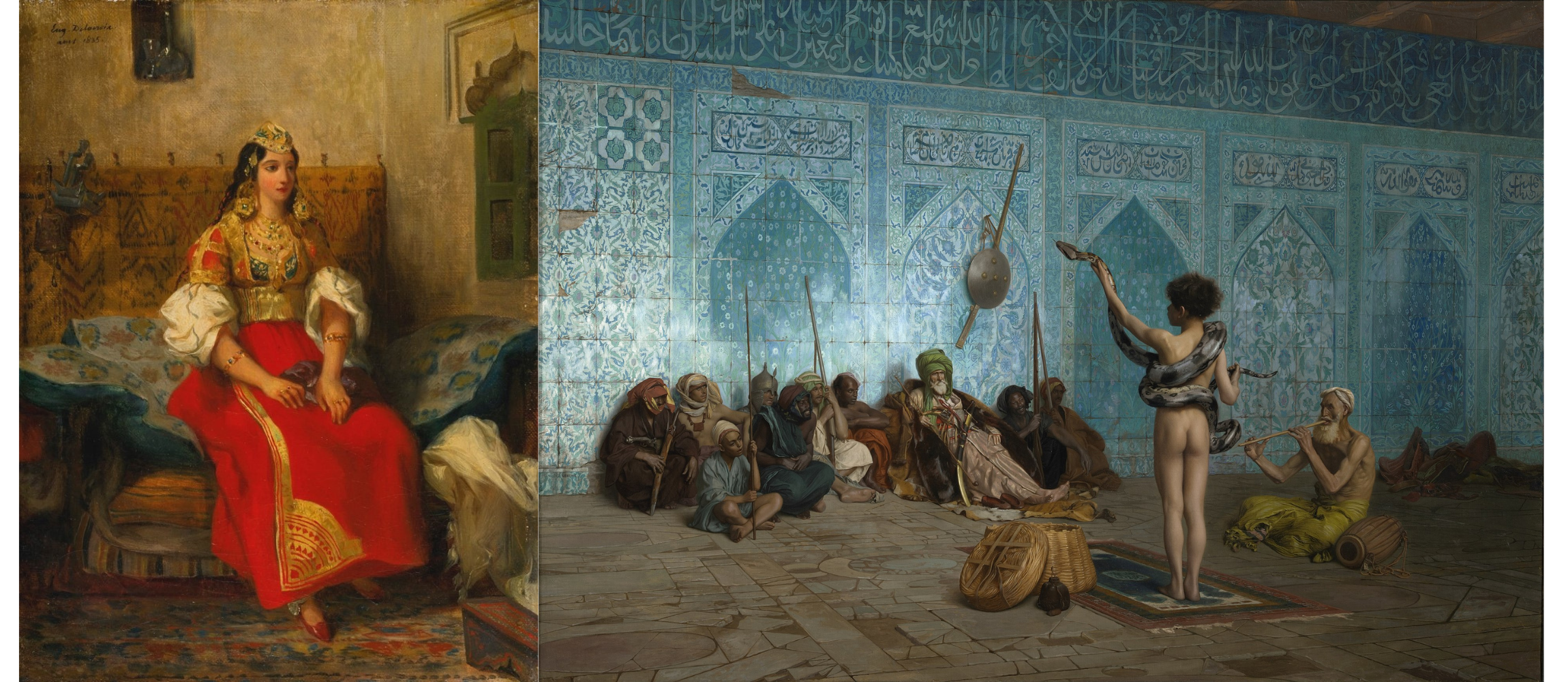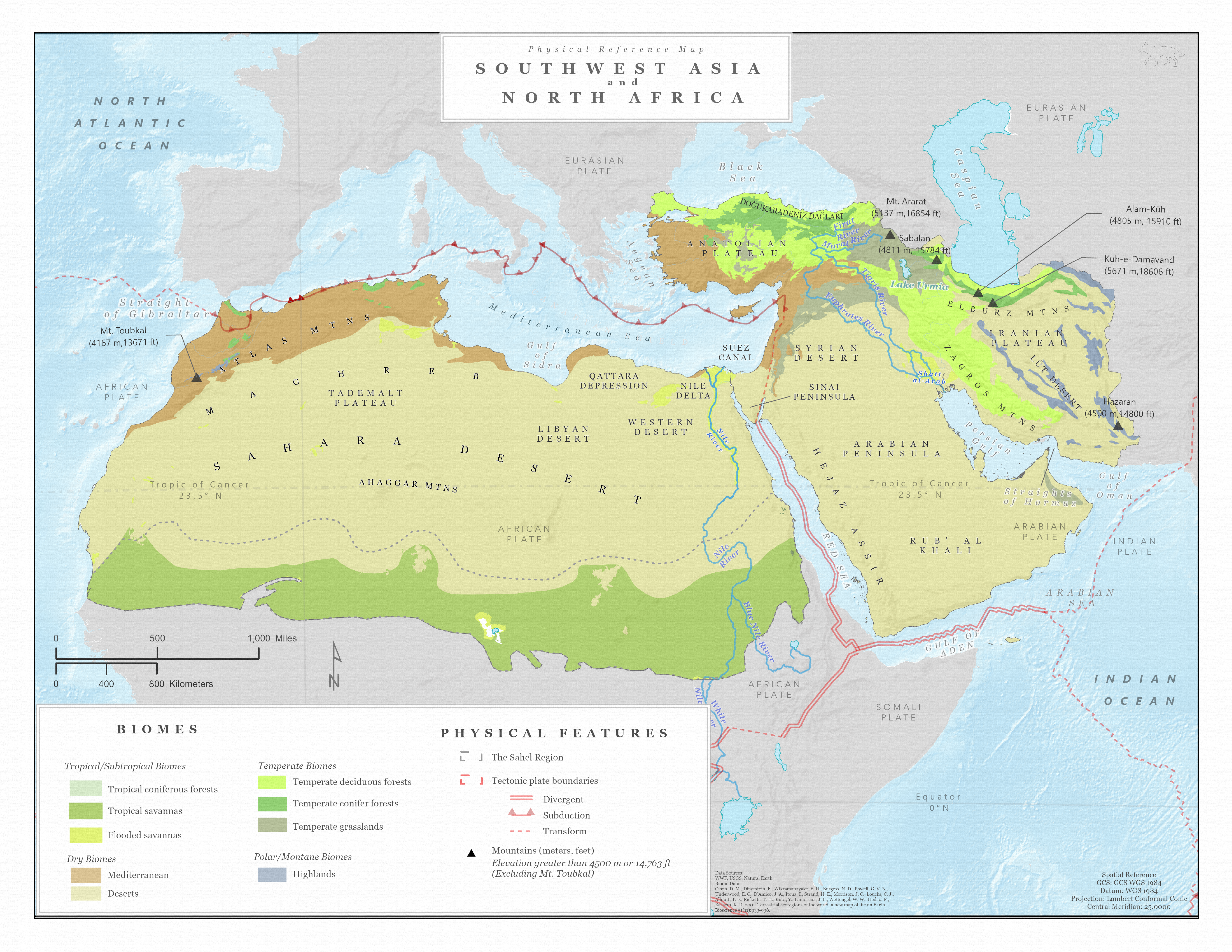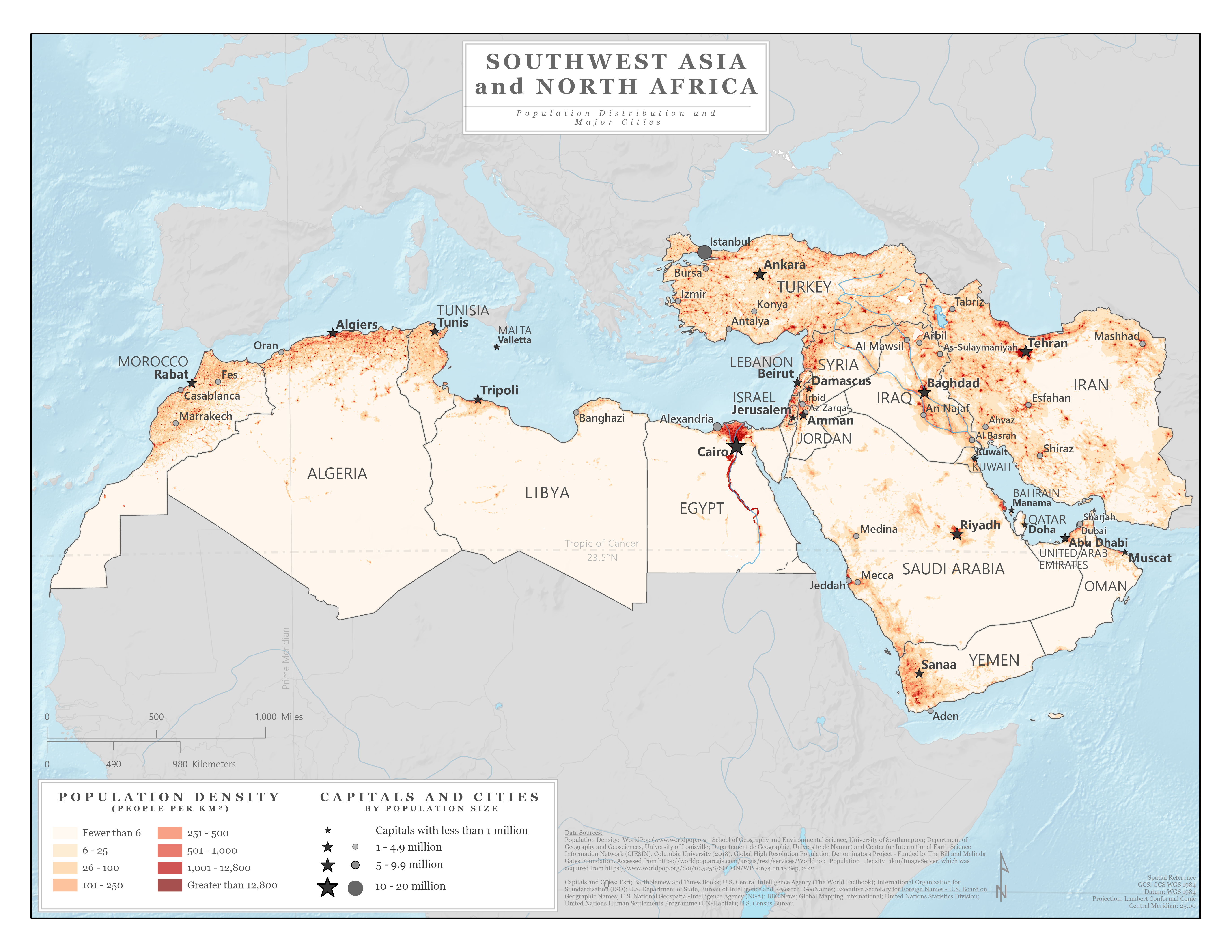4: Southwest Asia and North Africa
- Page ID
- 147509
\( \newcommand{\vecs}[1]{\overset { \scriptstyle \rightharpoonup} {\mathbf{#1}} } \)
\( \newcommand{\vecd}[1]{\overset{-\!-\!\rightharpoonup}{\vphantom{a}\smash {#1}}} \)
\( \newcommand{\dsum}{\displaystyle\sum\limits} \)
\( \newcommand{\dint}{\displaystyle\int\limits} \)
\( \newcommand{\dlim}{\displaystyle\lim\limits} \)
\( \newcommand{\id}{\mathrm{id}}\) \( \newcommand{\Span}{\mathrm{span}}\)
( \newcommand{\kernel}{\mathrm{null}\,}\) \( \newcommand{\range}{\mathrm{range}\,}\)
\( \newcommand{\RealPart}{\mathrm{Re}}\) \( \newcommand{\ImaginaryPart}{\mathrm{Im}}\)
\( \newcommand{\Argument}{\mathrm{Arg}}\) \( \newcommand{\norm}[1]{\| #1 \|}\)
\( \newcommand{\inner}[2]{\langle #1, #2 \rangle}\)
\( \newcommand{\Span}{\mathrm{span}}\)
\( \newcommand{\id}{\mathrm{id}}\)
\( \newcommand{\Span}{\mathrm{span}}\)
\( \newcommand{\kernel}{\mathrm{null}\,}\)
\( \newcommand{\range}{\mathrm{range}\,}\)
\( \newcommand{\RealPart}{\mathrm{Re}}\)
\( \newcommand{\ImaginaryPart}{\mathrm{Im}}\)
\( \newcommand{\Argument}{\mathrm{Arg}}\)
\( \newcommand{\norm}[1]{\| #1 \|}\)
\( \newcommand{\inner}[2]{\langle #1, #2 \rangle}\)
\( \newcommand{\Span}{\mathrm{span}}\) \( \newcommand{\AA}{\unicode[.8,0]{x212B}}\)
\( \newcommand{\vectorA}[1]{\vec{#1}} % arrow\)
\( \newcommand{\vectorAt}[1]{\vec{\text{#1}}} % arrow\)
\( \newcommand{\vectorB}[1]{\overset { \scriptstyle \rightharpoonup} {\mathbf{#1}} } \)
\( \newcommand{\vectorC}[1]{\textbf{#1}} \)
\( \newcommand{\vectorD}[1]{\overrightarrow{#1}} \)
\( \newcommand{\vectorDt}[1]{\overrightarrow{\text{#1}}} \)
\( \newcommand{\vectE}[1]{\overset{-\!-\!\rightharpoonup}{\vphantom{a}\smash{\mathbf {#1}}}} \)
\( \newcommand{\vecs}[1]{\overset { \scriptstyle \rightharpoonup} {\mathbf{#1}} } \)
\( \newcommand{\vecd}[1]{\overset{-\!-\!\rightharpoonup}{\vphantom{a}\smash {#1}}} \)
\(\newcommand{\avec}{\mathbf a}\) \(\newcommand{\bvec}{\mathbf b}\) \(\newcommand{\cvec}{\mathbf c}\) \(\newcommand{\dvec}{\mathbf d}\) \(\newcommand{\dtil}{\widetilde{\mathbf d}}\) \(\newcommand{\evec}{\mathbf e}\) \(\newcommand{\fvec}{\mathbf f}\) \(\newcommand{\nvec}{\mathbf n}\) \(\newcommand{\pvec}{\mathbf p}\) \(\newcommand{\qvec}{\mathbf q}\) \(\newcommand{\svec}{\mathbf s}\) \(\newcommand{\tvec}{\mathbf t}\) \(\newcommand{\uvec}{\mathbf u}\) \(\newcommand{\vvec}{\mathbf v}\) \(\newcommand{\wvec}{\mathbf w}\) \(\newcommand{\xvec}{\mathbf x}\) \(\newcommand{\yvec}{\mathbf y}\) \(\newcommand{\zvec}{\mathbf z}\) \(\newcommand{\rvec}{\mathbf r}\) \(\newcommand{\mvec}{\mathbf m}\) \(\newcommand{\zerovec}{\mathbf 0}\) \(\newcommand{\onevec}{\mathbf 1}\) \(\newcommand{\real}{\mathbb R}\) \(\newcommand{\twovec}[2]{\left[\begin{array}{r}#1 \\ #2 \end{array}\right]}\) \(\newcommand{\ctwovec}[2]{\left[\begin{array}{c}#1 \\ #2 \end{array}\right]}\) \(\newcommand{\threevec}[3]{\left[\begin{array}{r}#1 \\ #2 \\ #3 \end{array}\right]}\) \(\newcommand{\cthreevec}[3]{\left[\begin{array}{c}#1 \\ #2 \\ #3 \end{array}\right]}\) \(\newcommand{\fourvec}[4]{\left[\begin{array}{r}#1 \\ #2 \\ #3 \\ #4 \end{array}\right]}\) \(\newcommand{\cfourvec}[4]{\left[\begin{array}{c}#1 \\ #2 \\ #3 \\ #4 \end{array}\right]}\) \(\newcommand{\fivevec}[5]{\left[\begin{array}{r}#1 \\ #2 \\ #3 \\ #4 \\ #5 \\ \end{array}\right]}\) \(\newcommand{\cfivevec}[5]{\left[\begin{array}{c}#1 \\ #2 \\ #3 \\ #4 \\ #5 \\ \end{array}\right]}\) \(\newcommand{\mattwo}[4]{\left[\begin{array}{rr}#1 \amp #2 \\ #3 \amp #4 \\ \end{array}\right]}\) \(\newcommand{\laspan}[1]{\text{Span}\{#1\}}\) \(\newcommand{\bcal}{\cal B}\) \(\newcommand{\ccal}{\cal C}\) \(\newcommand{\scal}{\cal S}\) \(\newcommand{\wcal}{\cal W}\) \(\newcommand{\ecal}{\cal E}\) \(\newcommand{\coords}[2]{\left\{#1\right\}_{#2}}\) \(\newcommand{\gray}[1]{\color{gray}{#1}}\) \(\newcommand{\lgray}[1]{\color{lightgray}{#1}}\) \(\newcommand{\rank}{\operatorname{rank}}\) \(\newcommand{\row}{\text{Row}}\) \(\newcommand{\col}{\text{Col}}\) \(\renewcommand{\row}{\text{Row}}\) \(\newcommand{\nul}{\text{Nul}}\) \(\newcommand{\var}{\text{Var}}\) \(\newcommand{\corr}{\text{corr}}\) \(\newcommand{\len}[1]{\left|#1\right|}\) \(\newcommand{\bbar}{\overline{\bvec}}\) \(\newcommand{\bhat}{\widehat{\bvec}}\) \(\newcommand{\bperp}{\bvec^\perp}\) \(\newcommand{\xhat}{\widehat{\xvec}}\) \(\newcommand{\vhat}{\widehat{\vvec}}\) \(\newcommand{\uhat}{\widehat{\uvec}}\) \(\newcommand{\what}{\widehat{\wvec}}\) \(\newcommand{\Sighat}{\widehat{\Sigma}}\) \(\newcommand{\lt}{<}\) \(\newcommand{\gt}{>}\) \(\newcommand{\amp}{&}\) \(\definecolor{fillinmathshade}{gray}{0.9}\)Re-framing Southwest Asia and North Africa (SWANA)
When we define a region there are physical barriers and borders like mountain ranges and oceans, cultural distinctions like shared languages and religions, as well as historical reasons at the heart of the regional definition. Like with other world regions, each one of the places within Southwest Asia and North Africa (SWANA) has its own unique history, culture, and physical landscapes.
Although Islam, both Sunni and Shi’a, are dominant there are a multitude of other religious practices in this region. For example, Iran is a country predominantly identified with Shi’a Islam but is also home to traditions of Sufism, Judaism, Bahaism, Zoroastrianism, and Christianity. Minority groups are often overshadowed by majority groups giving the appearance of wholeness when in fact the whole is made up of diverse groups. Homogenizing a region in phrases like the East, “Arab World,” or “Muslim World” is inaccurate and dangerous. The dangers of monolith logic or the homogenization of any region are that it threatens the dignity of the diverse cultures, histories, and geographies of a region. For the purposes of this textbook the world region of SWANA extends from the Atlantic to the Indian oceans. SWANA countries border the Mediterranean, Red, and Arabian seas as well as the Persian Gulf. The region includes seventeen unique countries (see Figure 4.3).
When you hear the term “Middle East” what comes to mind? For many North Americans several images might dominate your geographical imagination: large expansive deserts, a dry climate, women in black shrouds, and men in turbans might be a few ideas that spring forward. If you were to spend a bit more time thinking about it you might add Islam, fundamentalism, and oil. Let’s unpack these broad strokes, generalizations, or stereotypes. Firstly, “Middle East” in relation to where? “Middle East” is only correct in relation to Europe and suggests that Europe is where geography begins and ends. This geographical tactic concretizes Europe as the center of the world. A less Eurocentric way to name this region of the world is Southwest Asia and North Africa (SWANA) because it uses the originating continent as its reference point.
In this chapter we acknowledge the existence, struggles, and resistances of indigenous people in SWANA. Indigenous peoples of Iran for example include Azeris, Kurds, Lurs, Baluch, and Arabs, Turkmen and other Turkic tribes, Armenians, Assyrians, and Afro-Iranians. Ethnic minorities named above are often unaccounted for in the state census. One of the most marginalized groups in Iran are the Dom who migrated from the Indian sub-continent in the 6th century. The Dom often live in quarantined areas with the majority of Dom, some 2.2 million people, living in southern Iran.
False polarization refers to the phenomenon of people perceiving a situation or issue as being more divisive than it is. This can occur when people are exposed to media that portrays two sides of an issue as being fundamentally opposed to one another, even if there is significant overlap or common ground between them. False polarization can lead to increased hostility and tension between groups and can make it more difficult to find common ground. Psychologists understand false polarization as a cognitive bias that functions to reduce cognitive dissonance (when belief and action are inconsistent) by assuming someone else’s views are more extreme than our own. In this case, the differences between SWANA and the west are often exploited for political and economic gain. The Pew Research center conducted a survey of traits associated with Muslims by westerners. They found that “fanatical, “honest”, and “violent” were the top three while Muslims associated “selfish,” “violent,” and “greedy” with westerners most often.
The concept of orientalism is critical for a discussion of SWANA. Orientalism is a way of thinking and acting that assumes that the cultures and societies of SWANA are inherently inferior to those of the West. It is a form of racism and cultural imperialism that involves stereotyping, fetishizing, and exoticizing these regions and their people. Orientalism is often evident in the way that people from these regions are portrayed in media, literature, and other forms of cultural production, and it can have real-world consequences in terms of how people from these regions are treated and perceived by others.
Edward Said, the Palestinian-American literary critic, authored a book in 1978 titled “Orientalism”. This seminal text has gone on to influence and spark complex investigations into how and why Europeans and North Americans conceptualize and represent SWANA the way they do. The first place to begin is with the term othering. Art and paintings more specifically have had a profound impact on how this region of the world was depicted from a Eurocentric perspective (see Figure above).
Centering Europe and decentering the rest of the world is a tactic that creates hierarchy and points of comparison. Processes of othering and imperialism are fundamental to structuring relations of power not only between races but between classes, genders, sexualities, and those who are labeled as different than the norm.
How then did Said define othering?
Othering refers to the process of treating someone or a group of people as fundamentally different or separatefrom oneself or one's own group. This can involve exclusion, discrimination, and even violence based on the perceived differences between the "self" and the "other." Othering is often based on factors such as race, ethnicity, nationality, religion, language, culture, and other aspects of identity. It can lead to dehumanization and marginalization of the "other" group and can have serious negative consequences for the people who are othered. It is often fueled by biases, stereotypes, and prejudices, and it can be a barrier to understanding, empathy, and social cohesion.
Orientalist paintings often depicted the East as backwards, lawless, and barbaric. In these paintings there was a preoccupation with harems and the exoticizing of eastern women who ironically were often endowed with distinctly western features, like light skin and thin eyebrows. Orientalist paintings worked to spread propaganda and the nationalist agendas of countries like France and England. Up until 1800, Europe had had little contact with this region of the world until Napoleon Bonaparte invaded Egypt in 1801 and shortly thereafter the twenty-four-volume Description de l’Égypte (1809–22), illustrating the topography, architecture, monuments, natural life, and population of Egypt began affecting Europe’s cultural imagination around the East. People, places, and things from lands unknown fed into the imagination of armchair tourists throughout Europe to delight in, be fearful of, and be curious about the unknown. Early imperialists from Columbus to Vasco da Gama aimed to reduce differences for governance and control. In contrast, exoticism is the deliberate focus on elevating cultural difference, even exaggerating cultural difference, to project a European fantasy onto far away people, places, and things.

For each of the world regions, our original atlas provides detailed maps to help you navigate the places discussed in this book. These maps are meant to be explored before and during the reading of this chapter. These maps are best enjoyed enlarged. Click on each map for an enlarged view, and zoom in to see the prominent biomes, physical features, and population centers of Middle and South America. We recommend that you download these for reference as you read this chapter's content and hope that you enjoy this original compilation.


References:
Blatz, C. W., & Mercier, B. (2018). False polarization and false moderation: Political opponents overestimate the extremity of each other’s ideologies but underestimate each other’s certainty. Social Psychological and Personality Science, 9(5), 521-529.
Zagumny, L., & Richey, A. B. (2013). Orientalism (s), world geography textbooks, and temporal paradox: Questioning representations of Southwest Asia and North Africa. International journal of qualitative studies in education, 26(10), 1330-1348.

